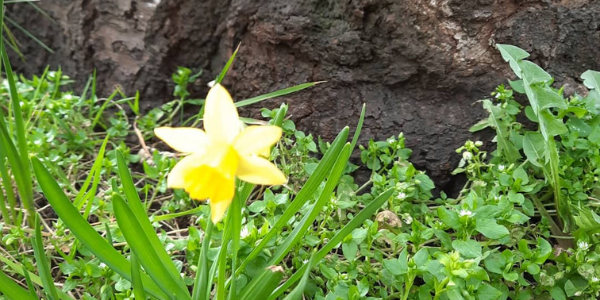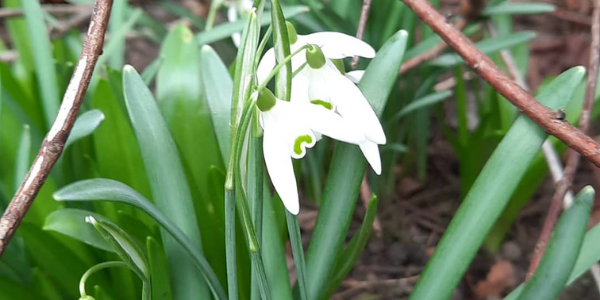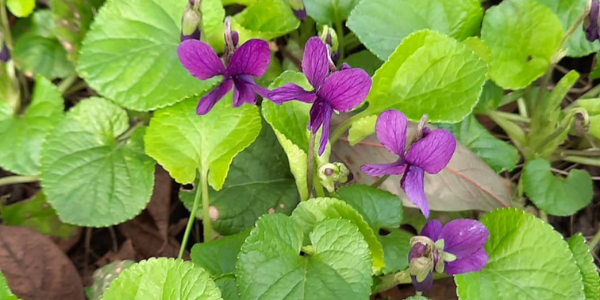Spring Flowers & Folklore
The snowdrop and primrose our woodlands adorn, and violets bathe in the wet o' the morn."
~ Robert Burns
“The first blooms of spring always make my heart sing.”
~ S. Brown
Spring is here, or almost. It’s that weird in between phase as the cycles of the seasons begin to transition into the next so that some days it feels almost warm and others a sprinkling of snow might threaten. But here, in my garden, the signs of spring are all around: the growing dawn chorus; birds collecting nesting material; buds on the trees and spring flowers beginning to bloom.
The garden in spring, with the bright colours of the daffodil, crocus, snowdrop and violet bring to mind folklore, stories and myth sand I’m reminded once more how important these are to us. I think a large part of society has forgotten the importance of storytelling as a way of sharing experiences and knowledge, and if something falls outside of what can be termed as STEM (science, technology, engineering and maths) is disregarded as unimportant, dismissed as old wives tales and nothing more. But we know, dear reader, that there are truths woven into the fabric of folklore, stories, myths and legends, don’t we? And so as I sip my coffee out in the garden, where a light spring wind makes the daffodils dance and the snow drops shiver, let me share with you some folklore and myths of my favourite springtime flowers.
Daffodils
‘She wore her yellow sun-bonnet,
She wore her greenest gown;
She turned to the south wind
And curtsied up and down.
She turned to the sunlight
And shook her yellow head,
And whispered to her neighbor:
"Winter is dead.’
~ A.A. Milne, When We Were Very Young
Daffodils are among my favourite of all flowers and are rich in folklore. A sign of good luck, in Wales it is said whoever shall see the first daffodil of the year will be blessed with good luck and abundance all year round. A sign of rebirth, they are also associated with honesty and faithfulness because they can be counted on to bloom every spring. Despite their associations with luck, you should always give a bunch of daffodils as to give just one is considered bad luck, and in some places in the UK, it is said good weather won’t arrive until after the last daffodil has died away.
Daffodils are the national flower of Wales and there is a particular species native to the country and widespread throughout Western Europe. Narcissus pseudonarcissus is also known as the Lent Lily, the Bellrose and wild daffodils but are becoming increasingly rare due to loss of habitat. The Welsh for Daffodil is Centinen Bedr, which roughly translates to St. Peter’s Leek.These are often worn on St. David’s Day. Some stories say that St. David ordered Welsh soldiers to wear leeks into battle against the Saxons, could this mean daffodil? Perhaps. The fact that they are in bloom around St. Davids Day add weight to the story.
Snowdrops
Baby lies so fast asleep
That we cannot wake her:
Will the angels clad in white
Fly from heaven to take her?
Baby lies so fast asleep
That no pain can grieve her;
Put a snowdrop in her hand,
Kiss her once and leave her.
~Christina Rossetti, Baby Lies so Fast Asleep
Clumps of these grow in the shaded parts of my garden, deep green stems and leaves and the whitest flowers! They truly are beautiful flowers and it’s almost as though they appear all of a sudden. Although not native to Britain (they are indeed an alpine plant), the snowdrop is a common sight in gardens and wild spaces alike.
One of my favourite stories about snowdrops is about how the snow got its colour. When the world and everything in it was new, the first snow fell but it didn’t have a colour and so it beseeched the flowers to lend some of their own. Arrogant and proud, each flower refused to share their colour with the snow, turning their backs to show their displeasure at being asked. Taking pity on the snow, the snowdrop came forward and offered its colour and this is why snow is white. In return, the snow gave the snowdrop its protection to bloom in the cold and this is why the snowdrops are often the first flower to appear in the spring.
Snowdrops are often called the Fair Maid of February and in Welsh are called Eirlys which means snow lily. While they are generally symbolising hope and purity, there is a darker aspect to them, often being associated with death. Not only are they a common graveyard flower, but the white bloom looks like a corpse wearing a shroud. It is also considered bad luck to pick the flowers and bring them into the home
Dog Violets
“My breath would catch at the sight of violets-so common in the woods at home, so surprising in the mountains. The violet's message was "Keep up your courage, stay true to what you believe in."
~Jessica Stern
These are some of my favourite spring time plants. They start in the corner of my garden beneath the boughs of the mature linden tree and spread across the lawn, their purple flowers like jewels in a sea of green. Violet honey is one of my favourite things to make, though only in small batches because I just can’t bring myself to pick too many of the beautiful blooms!
Violets are a symbol of fertility, as many springtime flowers are owing to their blooming in the spring when new life is just starting to emerge. The dog violet is so called as it is the common or wild variant of the species and doesn’t have the strong, sweet aroma of its cultivated cousin, the sweet violet. In Irish, the dog violet is called salchuach or cuckoos foot due to the spur that grows at the back of the flower.
As well as being symbols of fertility, they are also a flower of romance, hinted at in the rhyme ‘roses are red, violets are blue, sugar is sweet and so are you’. In the Victorian Language of Flowers, a purple violet signifies the sender is preoccupied with love for the recipient.
Violets are a humble little flower, not particularly large or showy, instead their beauty is of the quiet, unassuming sort and as such they are associated with humility. In Roman mythology, one of the goddess Diana’s nymphs was transformed into a violet to protect her from the amorous advances of Apollo. Keeping with the tradition of being transformed into a flower for protection or as punishment, it is said that Venus transformed a mortal girl into a violet after beating her blue. The reason? Because her son Cupid angered the goddess by saying he found the girl to be more beautiful.
Violets are also associated with luck and are said to ward off evil spirits.
So there you have it, some of the folklore and myths of my favourite springtime flowers. But really, the best way to experience the beauty of these flowers is to go outside and enjoy the unfurling spring where you live. Enjoy!
EMMA KATHRYN
Emma Kathryn, practises traditional British witchcraft, Vodou and Obeah, a mixture representing her heritage. She lives in the sticks with her family where she reads tarot, practises witchcraft and drink copious amounts of coffee.
You can follow Emma on Facebook.





